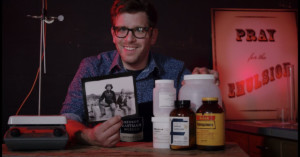
Analogue Wonderland Has Acquired SilverPan Film Lab
Analogue Wonderland, one of the leading shops and manufacturers of film photography in the United Kingdom, has acquired SilverPan Film Lab, a processing lab in Bristol.

Analogue Wonderland, one of the leading shops and manufacturers of film photography in the United Kingdom, has acquired SilverPan Film Lab, a processing lab in Bristol.

Zone Imaging has released a new film development fixer called Eco Zonefix that it claims is much safer than other products on the market and is, as the name suggests, eco-friendly.

One of the greatest things about film photography is its friendliness toward do-it-yourself approaches. Want to hack together a working camera out of discount hardware store supplies? All the power to you! Want to shoot on art paper coated in a home-concocted emulsion, contact-printed using authentic techniques from the 1800s? Why not?

The Instant Box Camera is a portable camera and darkroom all in one. It features a 110mm f/4.5 lens attached to a box that allows photographers to capture a photo and process the film all in one mobile photo studio.

Zone Imaging has announced a new film developer called 510 Pyro that it says is capable of rendering film grain much finer than previous developers, can do so with very small dilutions, and has a shelf life of more than six years.

If you're a film photographer who likes to go the do-it-yourself rather than store-bought route, here's a fun little tutorial for you. In this 3-minute Darkroom Magic episode by the George Eastman Museum, Historic Process Specialist Nick Brandreth shows how you can make your own photo paper developer at home from scratch.

LA-based analog photography company CineStill has just revealed the Cs6 "Creative Slide" 3-Bath Process, a family of slide film development kits that 'demystifies' slide processing and gives you unprecedented creative control over your results.

Last week, photographer Brendan Barry created a timely tutorial on how to turn your bedroom into a giant camera, and use it to take actual pictures. But what if you don't have any photographic chemicals around for developing and fixing those images? Barry's got you covered.

I had been working at a liquor store to get away from myself and all the photography things I knew well. The extra money was nice, however, my photography burnout had my creativity hostage and didn’t seem to have an end anytime soon. So when Dogfish Head announced their Super 8 Beer and the claim that you could develop film in it, I had to try it. Not actually develop film in it -- hell no! I’ve been digital for twenty years and a film cameras’ place was on the shelf for decoration and memories.

CineStill has launched new powdered versions of its color and black-and-white film development kits. The new "just add water" kits help photographers save both money and space.

A truly mass-market (and widely adopted) at-home automatic film processing machine has yet to appear in the world of photography. Photographer Mark Webb didn't want to wait around for one to show up, so he cobbled together one with his hardware and software knowledge. It's called the Developist.

CineStill just announced a "holy grail" of film photography: a single-step monobath called Df96 for processing any black-and-white film. The company says it's the world's fastest process -- one that can develop your film in just 3 minutes, from start to finish.

Ricoh has released the first-ever official software development kits (SDK) for Pentax cameras, opening the door to 3rd party apps for controlling the cameras remotely.

Picture it: it's Saint Patrick's Day, you've run out of Black & White film developer, all the stores are closed down... the only thing you can find is beer. Nothing worse could happen, but don't worry! We have the solution to develop your roll of film.

If you want sharp black and white images with fine grain, then you've come to the right place!

Developing your own color negative film at home might not be as scary as you think. With a simple developing kit, a few accessories, and a short tutorial, the folks at the Film Photography Project will show you how to do it in just 10 minutes.

In March 2014, we reported that inventor Bob Crowley and his startup New55 were working on producing a new line of 4x5 instant film. That Kickstarter campaign turned out to be a smashing success. As the company continues to work on its instant film aspirations, its has released a new product that many photographers may find useful.
It's a new monobath developer called R3 that lets you develop, stop, and fix black-and-white photographic film with a single bath.

In the past month and a half, Magic Lantern has seemingly made the impossible possible by bringing high definition RAW video to several Canon cameras and turning the cinema camera world upside down. With how fast these most recent updates have come out, it's easy to forget how much work has gone into Magic Lantern over the years.
A1ex from Magic Lantern's main development team wanted to remind us, and so he created this video representation of the work that the team has had put in to go from humble beginnings to the hack's current level of awesomeness.

Nikon released software development kits (SDKs) for its SLRs some time ago, allowing for developers to create software that play nice with Nikon cameras. Using the company's DSLR SDKs, savvy programmers can develop software that controls camera functions such as aperture, shutter speed and even shutter release.
Unfortunately, Nikon's SDKs are notoriously difficult to work with. But if you're just dying to control your SLR from your computer, SourceForge user Thomas Dideriksen has kindly done the heavy lifting for you by putting together an open source C# wrapper library that allows you to do just that.

At first glance, photographer Timothy Pakron's "Silver Print" series of portraits might look like ink paintings or some kind of CG art. They're actually photographs created by hand painting developer onto photo paper in the darkroom instead of immersing the paper entirely in the solution.

It looks like tap tap tap's Camera+ added one too many features for Apple's liking. When the app developers tweeted a secret workaround that enabled the volume button to double up to control the shutter, Apple pulled Camera+ from the App Store.
Just this week, developer John Casasanta wrote in a blog post that an upgraded version of the app originally intended to launch the feature, VolumeSnap. VolumeSnap would have also allowed users to use the volume control on iPhone headphones as a remote shutter control. Pretty nifty.
But Apple rejected tap tap tap's new version, citing this as a reason:
Your application cannot be added to the App Store because it uses iPhone volume buttons in a non-standard way, potentially resulting in user confusion. Changing the behavior of iPhone external hardware buttons is a violation of the iPhone Developer Program License Agreement. Applications must adhere to the iPhone Human Interface Guidelines as outlined in the iPhone Developer Program License Agreement section 3.3.7
So tap tap tap left out the feature -- at first. The app retained the feature, which was now hidden, but could be enabled by pointing the phone's browser to a specific site provided by the developers.